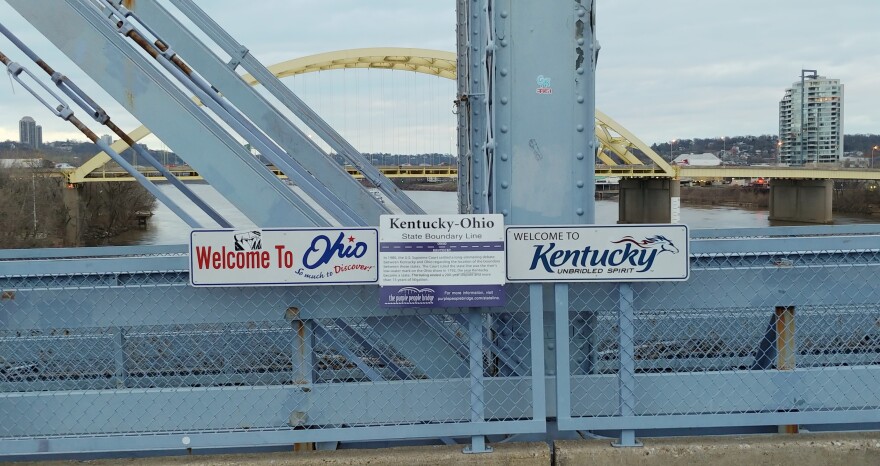Our feature OKI Wanna Know seeks answers to unusual questions. Today we look at the border between Kentucky and Ohio and Indiana. WVXU's Bill Rinehart explains.
Garry Zink of Independence was driving home from work when he noticed something.
"The 'Welcome to Kentucky' sign is almost immediately after you get on the bridge. And I wondered, 'Is that really the border?' So I checked on a map, and lo and behold, it looks like it is where the border is," Zink says.
He's right. Repeated court decisions have put the Kentucky border just off the far-side riverbank. That goes for Ohio, Indiana and Illinois, too.
It makes the Ohio River unique, according to UC College of Law Professor Brad Mank.
"Normally, if there's a river between either two American states or between two different nations, normally each nation, or each state, has half the river."
Mank says the reason goes back to Colonial America. When Virginia was a colony, it claimed a lot of land to the west, including what is now West Virginia, Ohio, Kentucky and Indiana. Virginia gave up some of those claims after the Revolutionary War.
" 'We're giving it up, but we're still claiming the northern boundary of the Ohio River,' " Mank explains. "They said, 'The Ohio River is ours.' "
Mank says Virginia's claims, including the Ohio River, transferred to Kentucky when Kentucky became a state in 1792.
Indiana challenged Kentucky's claim in 1820, after it became a state. The U.S. Supreme Court rejected Indiana's argument. Mank says Indiana tried again in 1890, and the high court still said no.
"It's the northern boundary, but it's the northern boundary as of 1792. So it's not the current boundary of the Ohio River, but it's the boundary that existed as of 1792. Which is a bit odd," Mank says. "Because there was some damming done in the river over the years and so the boundaries have changed slightly."
"Slightly" may be an understatement. For instance, that 1890 case was over Green River Island, between Evansville, Indiana, and Henderson, Kentucky. According to Northern Kentucky University history professor Paul Tenkotte, the river changed course enough that the island was no longer an island. Even today, it's part of Kentucky, but is physically attached to Indiana.

You may be wondering why this all matters. Tenkotte says that's the big question.
"Who cares, right? Who cares where the boundary is? (It) must have been money and other things. Money and power behind all of it. Otherwise people wouldn't spend money to take it to court."
Tenkotte says bridges were owned by private companies, which paid property taxes, on one side of the river or the other. That includes mineral rights, fishing rights and any associated taxes.
"In the 1800s, there was actually a court case of a Cincinnati justice of the peace, who performed a marriage ceremony on a ferry that operated between Newport and Cincinnati. Kentucky indicted him for claiming to do this marriage when the river was Kentucky's river. It's all about power. It's about money."
Ohio watched these cases but didn't get involved because the state didn't have a different argument. Until 1966, when Ohio said the boundary should be more flexible. The state wanted the border to be where ever the low water mark was.
UC's Brad Mank says that challenge bounced around the courts for a few years. A special master assigned to the case rejected Ohio's argument saying it was difficult to determine where the 1792 boundary was, but it wasn't impossible.
Finally in 1980, the case wound up in the Supreme Court. Mank says the three dissenting justices argued that the border should change as the river changes. Which is what happens with the Mississippi and Missouri rivers.
"But for the Ohio River, because it's based on what Virginia gave up in 1784 and 1792, it's all based on the historical boundaries and not where the river is," Mank says. "It seems awfully inconvenient, but that's what the Supreme Court said."
That's why the signs welcoming visitors to Kentucky are close to the Ohio side on bridges. It's also why Kentucky is responsible for those bridges.
This story has been updated to clarify when Indiana challenged Kentucky's ownership.
Got a question about Ohio, Kentucky or Indiana you want answered? Submit it below and we may answer it.



